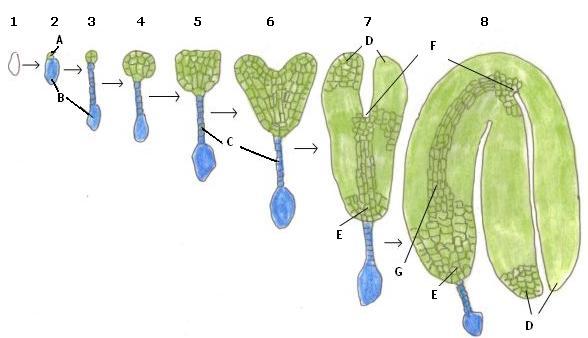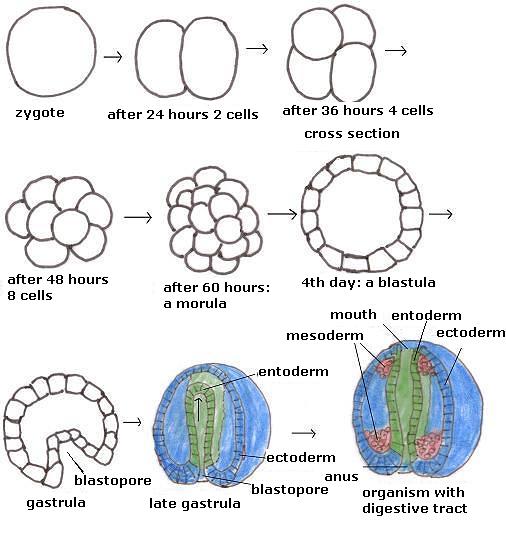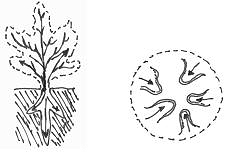
Man does not become human,
but is always human.
Erich Blechschmidt
Plant and animal
n this page the embryonic development of a flowering plant and a simple animal (a sea urchin) are described and compared from a Goethean point of view, also known as phenomenology. The fundamental difference between the shape and essence of a plant and an animal will be explained.
The first time a technical term appears, the English translation is given in parentheses.
The development of the embryo of the plant
When plants flower, pollen will be carried from the stamens to the stigma of the pistil by wind, insects or other animals. The pollen makes a tube through the style of the pistil to the egg cell in the ovary. Fertilization takes place and then follows the first division (see Fig. 1, stage 2), by which a small apical cell (A) and a large basal cell (B) are formed. The apical cell divides into four cells and forms a small ball. The basal cell ligates cells at the top (stage 3). The apical clump of cells grows and forms a spherical ball. The lower part with the basal cell stops growing and dividing quite soon (stages 4 and 5). This part is called the suspensor (C). This stage (5) is called the globular stage of the embryo.
The apical tissue grows sidewards (stage 6), the cotyledons (D) are formed from this. At the same time the tissue between the cotyledons and the suspensor differentiates into the growing point of the root (or apical root meristem, E), the growing point of the shoot (or apical shoot meristem, F) and the connective vascular tissue (G), stages 7 and 8. The cotyledons grow and fold out. The seed (e.g. a peanut) is formed.
The seed grows further and goes into rest. It starts to grow again only when it goes into the ground and the conditions are favourable for germination. One might speak of "a double fertilization". First, the pollen fertilizes the egg, then the seed has to fall or be sown into the earth. The seed (male) is received by Mother Earth.
The following processes are visible:
- right from the first division the embryo is growing;
- immediately there is cell differentiation, the apical and basal cells are different;
- the tissue is solid.

Figure 1. The development of the embryo of the plant
See text for description. A: top cell; B: basal cell; C: suspensor; D: cotyledons; E: root meristem; F: stem meristem; G: vascular tissue
The development of the embryo of a simple animal (e.g. a sea urchin)
At fertilization an egg cell and a sperm cell fuse and create a zygote (= fertilized egg). After 24 hours the first division takes place: two equally big cells are created, each being half the size of the zygote. After that the divisions occur approximately every 12 hours. The embryo is and stays spherical and does not grow. The stage of 16 to 64 cells is called a morula (= mulberry) (see Fig. 2, the fifth stage, side view).
Then the cells that lie inside migrate from the centre to the periphery, some cells die in the middle and there a cavity is formed. This cavity is filled with fluid. The embryo is now called a blastula (= small button, Fig. 2, the sixth stage, a cross section) and starts to grow.
The cell divisions in the wall of the blastula continue and then some cells bend inwards to make a tube to the inside. This indentation looks as if a finger is pushed inwards. This happens at the spot that is called the blastopore (= opening of the vesicle)(Fig. 2, stage 7 and 8). The embryo is now called a gastrula (gaster = stomach). This indentation-process continues until the indentation reaches the opposite wall. Then the tissue breaks open. Out of the blastopore the anus is formed and the new breakthrough forms the mouth. Between these two a tube is formed that will become the digestive tract. Between the digestive tract and the outer wall or skin, a body cavity is formed in which clumps of cells (the mesoderm) are formed out of which the organs will develop.

Figure 2: The embryonic development of a sea urchin (schematically)
See text for an explanation. A cluster of cells is formed, in which a cavity is formed on the fourth day. Then an indentation arises, which breaks through on the opposite side. The result is an organism which has a digestive tract and a body cavity with clumps of mesoderm cells. From the blastula on cross sections are given. In the late gastrula and the last drawing, the organism is cut and is half visible. Ectoderm is blue, entoderm green and mesoderm red.
Three types of tissue are formed:
- an outer membrane or outer skin, or ectoderm (ecto = outside and derma = skin, blue)
- an inner membrane or inner skin, or entoderm (also called endoderm; ento = inside, green)
- and between them a cavity in which there is in-between tissue or mesoderm (mesos = middle, red).
These three tissues are called the three germ layers. Later on all tissues and organs will grow out of them.
Two cavities came into being:
- the digestive tract; an external cavity created from the outside a bit of the outside world in the body, which stays in contact with the world outside through the mouth and the anus and
- the body cavity; the cavity between the skin and the digestive tract. This cavity has no connection to the world outside. In this cavity all organs and the centre of the body will develop.
The following processes are visible:
- in the beginning there is no growth,
- in the beginning there is no cell differentiation,
- two different cavities are formed.
Differences between plants and animals
The embryonic development of plants and animals is different. Plants show immediate growth, animals do not at first. The cells of plants differ immediately, whereas this is not the case with animals. Plants are solid and animals have two body cavities. Animals bend inwards and make a body cavity and plants do not form an inner space.
This can also be seen later on. Plants grow on the ends of their twigs, their shoots and roots directed to the surroundings. The growing points are always placed at the ends of twigs, stems and roots, in the periphery. Processes take place on the outside. Growth-rate and size are largely determined by the environment. A plant on poor sandy soil grows less well than a plant on nutrient-rich clay. Plants are in the environment.
Animals grow to a certain (somewhat variable) size and then stop growing. They are not influenced by the environment as much as plants. Plants are fixed in the earth, animals can move. Plants do not have an inner cavity nor a centre, animals do (the heart). Animals have developed an interior space, in which processes take place and they have an inner life. See Fig 3.

Figure 3. The growth directions of a plant and an animal (from van der Wal (2003): Hartmann)
Hartmann has four drawings of the growth- directions in relationship to the centre and the environment of the mineral, the plant, the animal and man, that are useful in embryology.
The plant grows up and down from a point (the meristem points) and then into the periphery - the air and the soil. The animal grows inwards.
In anthroposophy the inner life of animals is linked to the inner space of the body cavity. The cavity is the basis for the astral body, the non-physical body in which the soul capacities observing and thinking, feeling and willing and doing take place. Plants do not have a soul nor body cavities. Plants and animals both have an ether- or vital body. Plants can grow freely, animals cannot, because they are orientated on their centre, as shown by the gastrula. In table 1 the differences between plants and animals are summarized.
| plants | animals | |
| growth | at once, at the first division | not at first, later on |
| cell differentiation | at once | later on |
| body cavities | non | digestive tract and body cavity |
| orientation | environment | the inner centre |
| centre | non | the heart |
| levels of being | physical and vital body | physical, vital and astral body |
Table 1. Differences between plants and animals
